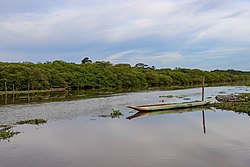Jaguaripe River
| Jaguaripe River | |
|---|---|
 Mangroves along the Jaguaripe River, Maragogipinho | |
| Native name | Rio Jaguaripe (Portuguese) |
| Location | |
| Country | Brazil |
| States | Bahia |
| Region | South America |
| Physical characteristics | |
| Length | 107 km (66 mi) |
| Basin size | 2,200 km2 (850 sq mi) |
The Jaguaripe River (Brazilian Portuguese: Rio Jaguaripe) is a river located in Bahia, Brazil. It is administered by the state of Bahia under Region of Planning and Water Management IX, the Recôncavo Sul. The river derives its name from the Tupi language term îagûarype, meaning "in the river of jaguars" (îagûara, jaguar + 'y, river + pe, em). The river extends 107 kilometres (66 mi) from the municipality Castro Alves and empties into the Bay of All Saints. It is one of three large rivers that flow into the bay, the others being the Paraguaçu and the Subaé. The Rio da Dona flows parallel to the Jaguaripe, and joins its near the mouth of the bay.[1][2]
The river basin was home to speakers of Macro-Jê languages, ancient inhabitants of the Recôncavo Baiano region. They were expelled by the Tupi people, who emerged from the Amazon in approximately the 11th century. The Portuguese arrived in the 16th century and encountered Tupinambá settlements. The river became home to important commercial centers, with Nazare das Farinhas near its source; Maragogipinho, a district of Aratuípe to the southeast; and Jaguaripe near the mouth of the river at the Bay of All Saints.[2]
The river has rich stands of mangroves among much of its lengths, as well as several small islands: the Paraíso, Carapeba, Santo Antônio de Jiribatuba, and Matarandiba. The Jaguaripe terminates at the Funil Bridge, which connects the Bahian mainland to the island of Itaparica.
References
- ^ Eduardo de Almeida Navarro (2013). Dicionário de Tupi Antigo: a língua indígena clássica do Brasil: vocabulário português-tupi e dicionário tupi-português, tupinismos no português do Brasil, etimologias de topônimos e antropônimos de origem tupi (in Portuguese and tup) (1st ed.). São Paulo: Global Editora. p. 579. ISBN 978-85-260-1933-1. OCLC 869424504. OL 31098498M. Wikidata Q107351543.
{{cite book}}: CS1 maint: unrecognized language (link) - ^ a b Cid Bonfim Santos; Rafael Cabral Carvalho; Guilherme Lessa (2003). "Distribuição dos manguezais na Baía de Todos os Santos e seu impacto no balanço hídrico". II Congresso sobre Planejamento e Gestão das Zonas Costeiras dos Países de Expressão Portuguesa (in Portuguese). Wikidata Q107364870.
External links
![]() Media related to Jaguaripe River at Wikimedia Commons
Media related to Jaguaripe River at Wikimedia Commons

